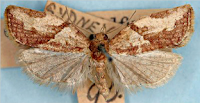USDA Pledges Millions For Light Brown Apple Moth Eradication

Elizabeth Larson
Capital Press
The U.S. Department of Agriculture is stepping up its efforts to fight the light brown apple moth, announcing last week that it intends to offer a five-fold increase in funds for the moth's eradication program.
In a statement released Jan. 24, then-acting Agriculture Secretary Chuck Conner said USDA would make available $74.5 million in emergency funding to continue efforts in California to stop the moth's spread.
USDA provided $15 million in emergency funding last August. California Department of Food and Agriculture and USDA have continued working cooperatively on surveillance, trapping and treatment, USDA reported.
In the statement Conner said those efforts have contained the moth in the initial quarantine area, which resulted in lifting control quarantine restrictions in two of the 12 infected California counties.
While the intensive eradication effort will still remain largely centered in California - where the moths were confirmed last March in the Bay Area - USDA spokesman Larry Hawkins said plans for 2008 include a 50-state national detection survey to verify that light brown apple moth is not present anywhere else in the continental United States.
USDA reported that it plans to target nursery stock in that survey, along with orchards and urbanized areas with ornamental plantings that are attractive to the light brown apple moth.
Hawkins did not have a cost breakdown for how much of the USDA emergency funding would go to the survey and how much would be spent in California.
USDA emphasized the need to eradicate the moth because of its wide host list, including more than 2,000 plant species, as well as its threats to California's natural environment - including its redwood and cypress tree populations.
The difference in funding for 2008 will allow eradication treatments to broaden significantly. Hawkins said pheromone twist-ties applied to trees and bushes will increase, a treatment that he said is labor-intensive because they have to be placed by hand.
CDFA and USDA also announced last week a range of other new treatment options in addition to those already in use, including use of a male attractant and introduction of tiny Trichogramma wasps that lay their eggs in light brown apple moth eggs.







0 comments:
Post a Comment